Did you know the Snake Plant is also called ‘Mother-in-Law’s Tongue’? It is a trendy indoor plant and a great air purifier. It looks unique and helps clean the air, which is why many people love it.
Key Takeaways:
- Snake Plant, also known as ‘Mother-in-Law’s Tongue’, is a popular indoor plant.
- Snake Plant is highly effective in purifying indoor air, making it ideal for improving indoor air quality.
- Snake Plant is considered pet-friendly and non-toxic to cats and dogs.
- Snake Plant stays relatively compact in size, making it suitable for apartments and smaller living spaces.
- Understanding the growth habits, care requirements, and propagation methods of Snake Plant will help you successfully grow and maintain this beautiful indoor plant.
Why Do We Love the Snake Plant / ‘Mother-in-Law’s Tongue’ For Apartments?
Many people pick the Snake Plant for their apartments. It has lots of benefits.
This plant cleans the air and is safe for pets. It’s great for small places.
Is the Snake Plant / ‘Mother-in-Law’s Tongue’ Air-Purifying?
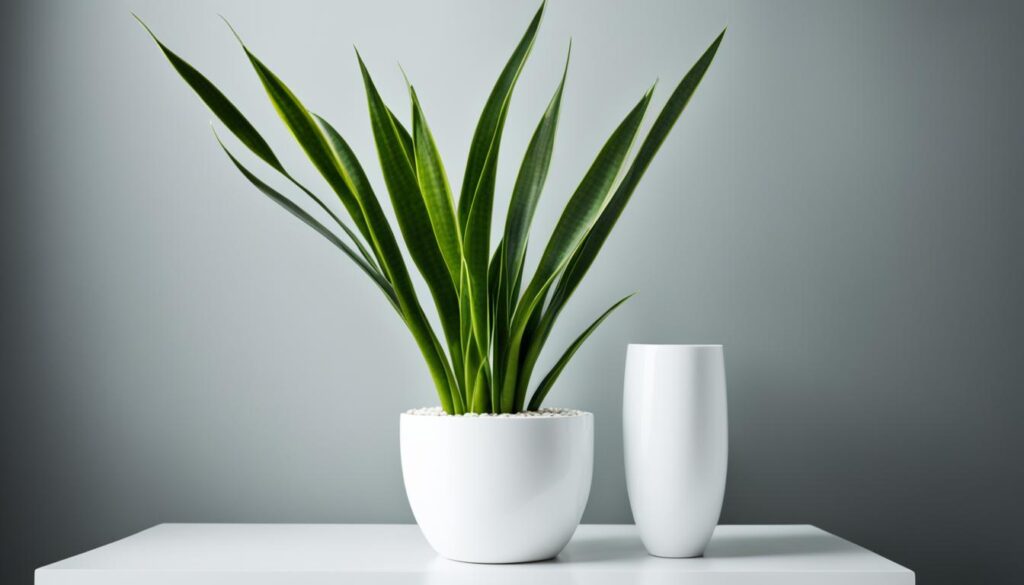
The Snake Plant purifies the air. It removes harmful stuff like benzene and formaldehyde.
It makes oxygen at night. This can help you sleep better.
Is the Snake Plant / ‘Mother-in-Law’s Tongue’ Pet Friendly?
It’s safe for cats and dogs. But, keep an eye on your pets around it.
Even though it’s safe, try to keep it away from pets. They might chew it.
How Big Does the Snake Plant / ‘Mother-in-Law’s Tongue’ Get?
The Snake Plant is perfect for small places. It doesn’t get too big.
It grows up but doesn’t take much space. It’s great for adding green without clutter.
How to Grow a Snake Plant / ‘Mother-in-Law’s Tongue’ – Learn to Grow this Indoor Beauty
Let’s talk about growing a Snake Plant. We’ll look at what’s important for its health and growth.
Choosing the Right Pot and Soil
Picking the right pot is key. It needs to let water flow through well. Use succulent or cactus soil to avoid too much water. This mix helps the roots grow strong and keeps the plant happy.
Providing Adequate Light
Snake Plants need light but not too much. They do best in bright places without direct sun. Put yours near a window that gets indirect sunlight to make it thrive. Too much sun can hurt the leaves.
Watering and Humidity
Snake Plants don’t need a lot of water. Wait until the soil is dry before watering again. This stops the roots from rotting. Keep the air around it not too dry or wet for best health.
Nutrition and Fertilization
This plant hardly needs to be fed. Give it light fertilizer twice a year for growth. Make sure not to overdo it. Too much can harm the plant.
Pruning and Maintenance
Cutting off bad leaves keeps the plant looking good. Use clean shears for this. Wipe the leaves with a wet cloth to remove dust and dirt.
Propagation
You can make new Snake Plants from cuttings or by splitting the plant. Both ways help you get more plants to enjoy or give away.
Monitoring for Pests and Diseases
Watch out for bugs and sickness. Treat problems quickly to keep your plant healthy. Common pests to look out for include gnats and spider mites among others.
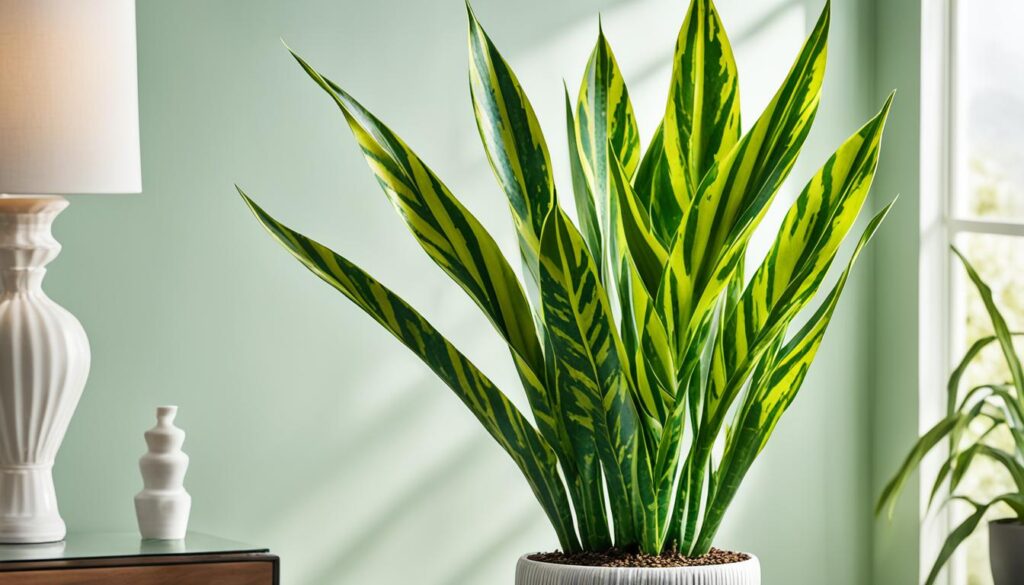
Appearance of Snake Plant / ‘Mother-in-Law’s Tongue’
The Snake Plant is also called ‘Mother-in-Law’s Tongue.’. It has a look that stands out. It has stiff, sword-like leaves that make any room look nicer. The leaves are green with yellow or cream on the edges. They look striking together.
There are many types of Snake Plants. Each one looks a bit different. Some have big leaves, some have small ones. Their leaf patterns can be simple or detailed. It’s good to know about these to take care of them right. One popular variety is the Mikado Snake Plant, known for its striking upright leaves and unique coloration. To ensure its health and vibrancy, it’s essential to follow some Mikado Snake Plant care tips, such as providing indirect light and allowing the soil to dry out between waterings. Additionally, these plants thrive in well-draining soil, making them perfect for low-maintenance indoor gardening.
Take a look at the image below to get a better idea of the Snake Plant’s appearance:
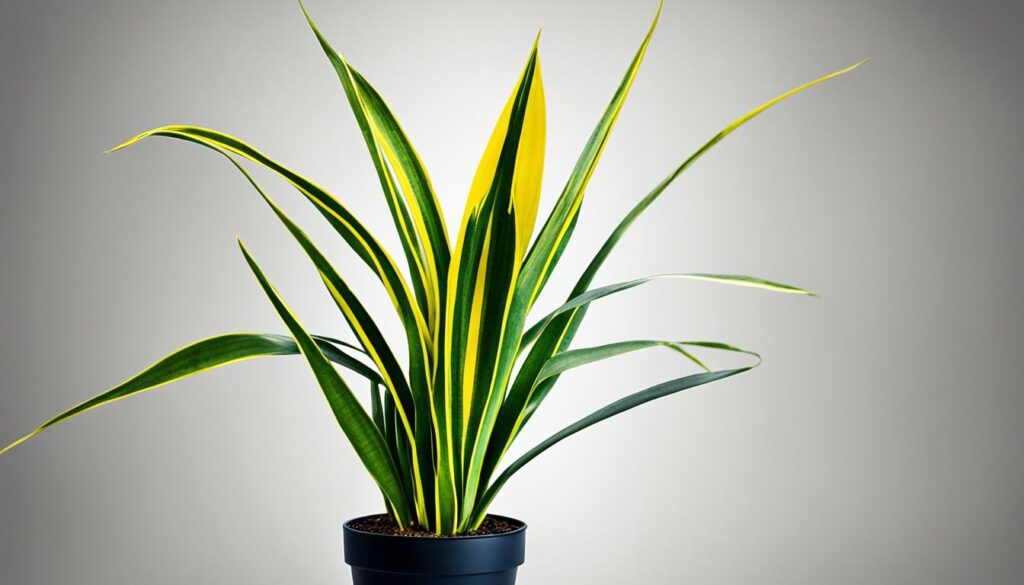
As you can see, the Snake Plant looks special. It makes any home or office look better. You can choose from many types, whether you like simple green or fancy leaves. This plant will surely grab attention and make your space prettier.
Light Requirements for Snake Plant / ‘Mother-in-Law’s Tongue’
Snake Plants need the right light to grow well. They do best in indirect sunlight. But, they can handle some direct morning sun too. It’s key to find the right amount of light. This helps them make food without getting leaf burn.
To show what Snake Plants need, here’s a picture showing light requirements:
| Light Level | Description |
|---|---|
| Indirect Light | Put the Snake Plant where it gets bright, filtered light all day. But keep it out of strong afternoon sun. |
| Direct Morning Sunlight | A bit of direct sun in the morning is good. But don’t let it get too much. It keeps them looking bright and healthy. |
| Avoid Excessive Sunlight | Too much direct sun, especially later in the day, can hurt the leaves. Watch how much sun it gets and move it if needed. |
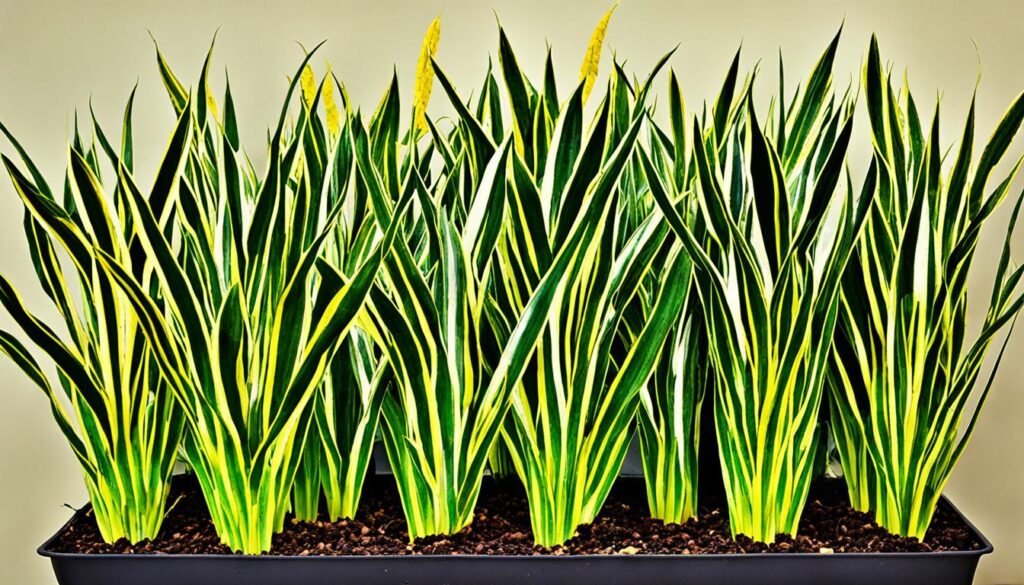
With the right light, your Snake Plant will look great. Watch how it does with light and adjust as needed. This will help it grow strong.
Watering Requirements of The Snake Plant / ‘Mother-in-Law’s Tongue’
Snake Plants need the right amount of water to stay healthy. They don’t need a lot of water and can get sick if they get too much. Let the soil dry out before you water them again.
They like soil that drains well. Too much water makes their roots soggy and harms the plant. These plants come from dry areas in West Africa. They are used to not having much water.
Wondering how often to water a Snake Plant? Watering every 2-3 weeks is usually best. The right time to water can depend on the pot size, soil type, and your home’s environment.
To see if your plant needs water, check the soil. Put your finger an inch into the soil. If it’s dry, water your plant. If it feels wet, wait a bit longer.
Soon, you’ll know just when your Snake Plant needs water. It’s key to water them less rather than too much. They handle dryness better than being too wet.
Signs of Overwatering vs. Underwatering:
| Overwatering | Underwatering |
|---|---|
| – Yellowing leaves | – Wrinkled or wilted leaves |
| – Soft and mushy roots | – Dry and brittle leaves |
| – Foul odor from the soil | – Stunted growth |
| – Leaf drop | – Slow growth or no new growth |
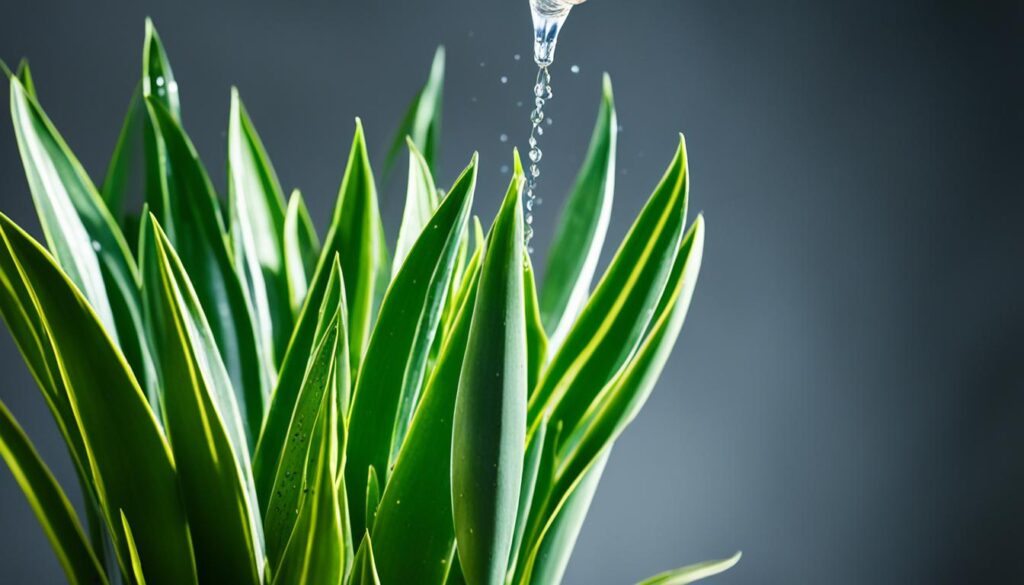
Fertilizing Snake Plant / ‘Mother-in-Law’s Tongue’s
Recommended Fertilizer for Snake Plant / ‘Mother-in-Law’s Tongue’
It’s very important to feed Snake Plants right to keep them looking great. They don’t need much food, but a little helps them grow well.
A half-strength 10-10-10 fertilizer works best for Snake Plants. This gives them all the important food they need without overdoing it.
To feed your plant well, just follow these easy steps:
- Water the plant well first. This stops the roots from getting hurt by the food.
- Mix the food with water just like the directions say. Make it half as strong.
- Put the food water around the bottom of the plant. Spread it out all over.
- Keep the food off the leaves to avoid any damage.
- Give food to your plant two times a year, in spring and mid-summer. This keeps it happy and healthy.
By feeding your Snake Plant on time with the right food, it will stay healthy and beautiful. It will get everything it needs to look its best.
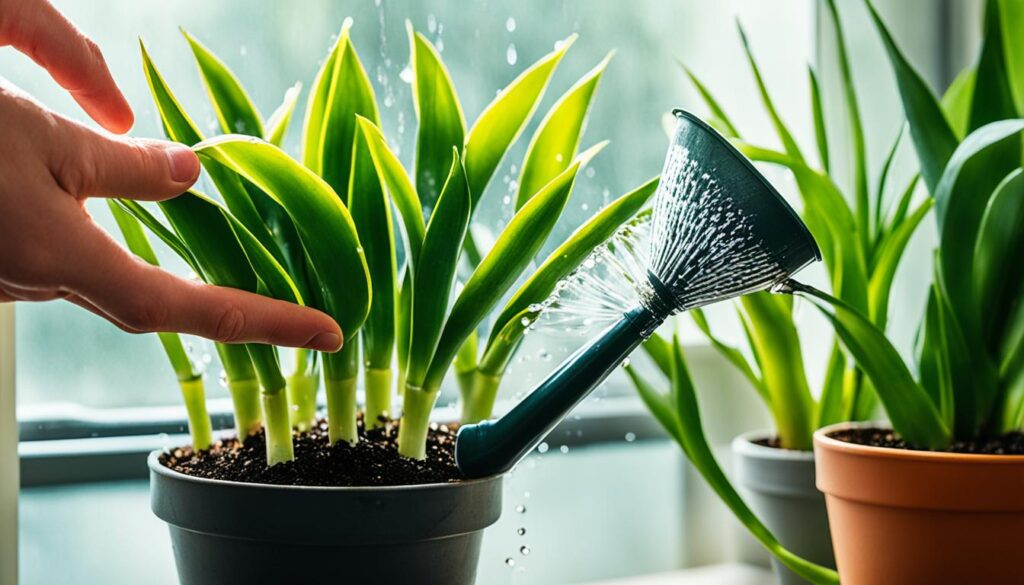
Potting Snake Plant / ‘Mother-in-Law’s Tongue’s
Proper potting helps the Snake Plant grow and stay healthy. The right pot size and well-draining soil are key. Also, repot when needed for better roots and health.
Choosing the Right Pot Size
The pot size for your Snake Plant matters a lot. It should not be too big or too small. A pot that’s one to two inches larger than the old one is perfect. It gives space for roots without risking root rot.
Using the Right Potting Mix for Snake Plant / ‘Mother-in-Law’s Tongue’
This plant needs soil that drains well. Use a mix of regular soil, perlite, and coarse sand or orchid bark. This mix helps avoid too-wet soil and keeps roots happy.
Repotting When Necessary
Sometimes, your plant needs a new home. If roots peek out of the pot or it looks too crowded, it’s time. Spring or early summer is the best time to do this.
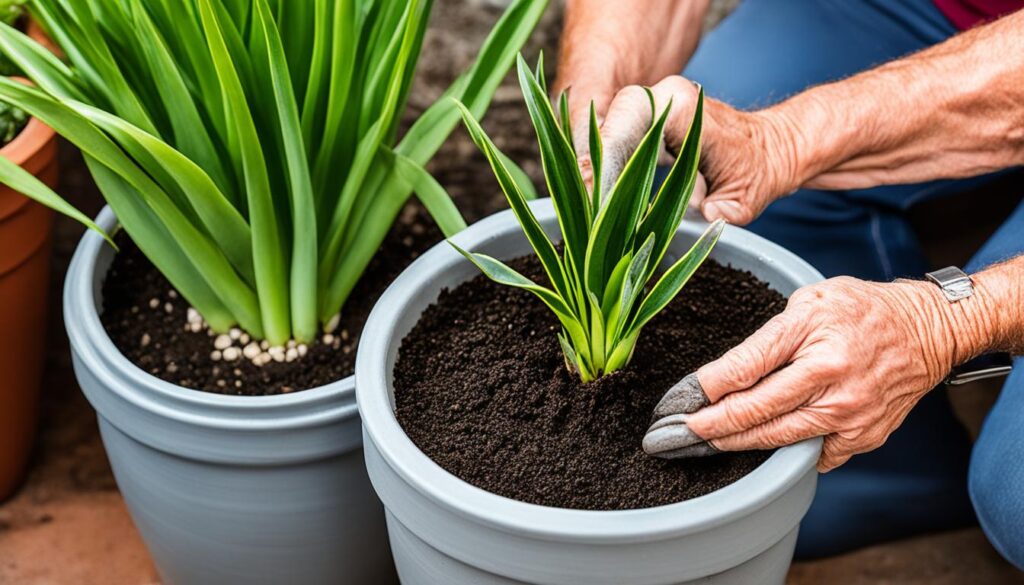
Propagating Snake Plant / ‘Mother-in-Law’s Tongue’s
Want more Snake Plants? You can do it with stem cuttings or division. This is how you share their beauty.
Stem Cuttings Or Seeds?
Stem cuttings are a popular, easy way to make more Snake Plants. Here’s what to do:
- Pick a healthy, big leaf from the Snake Plant.
- Cut the leaf into pieces with a clean knife. Each should be two inches long.
- Let the pieces dry for some days. They will form calluses.
- Put them in a pot with good soil. They should go one inch deep.
- Water them a little. Put the pot where it’s warm and bright but not in direct sunlight.
- Keep the soil moist. In a few weeks, roots will grow if all is well.
Seeds can grow Snake Plants too, but it’s less common. To use seeds, do this:
- Get fresh seeds or collect them from a flowering Snake Plant.
- Plant them in good soil and cover them lightly.
- Put the pot in a warm, bright spot. No direct sunlight.
- Keep the soil warm and moist. The right temperature is 70-75°F (21-24°C).
- Wait for them to sprout. It takes weeks or months. When they have leaves, move them to their pots.
Division Of A Snake Plant / ‘Mother-in-Law’s Tongue
Splitting a big Snake Plant is also a good way to get more plants. To split one, do these steps:
- Take the plant out of its pot carefully. Don’t hurt the roots.
- Break it into smaller parts. Each should have its own roots.
- Cut off any bad roots.
- Get pots ready with good soil.
- Plant each part in a pot. The roots should be covered, and the plant straight.
- Water them a bit. Put the pots where it’s warm and bright without direct sunlight.
- Keep the soil moist. Let it dry a bit before watering again.
To grow your Snake Plant family, know the good and bad of each way. Then, follow the steps. You can make your Snake Plants grow and share their beauty.
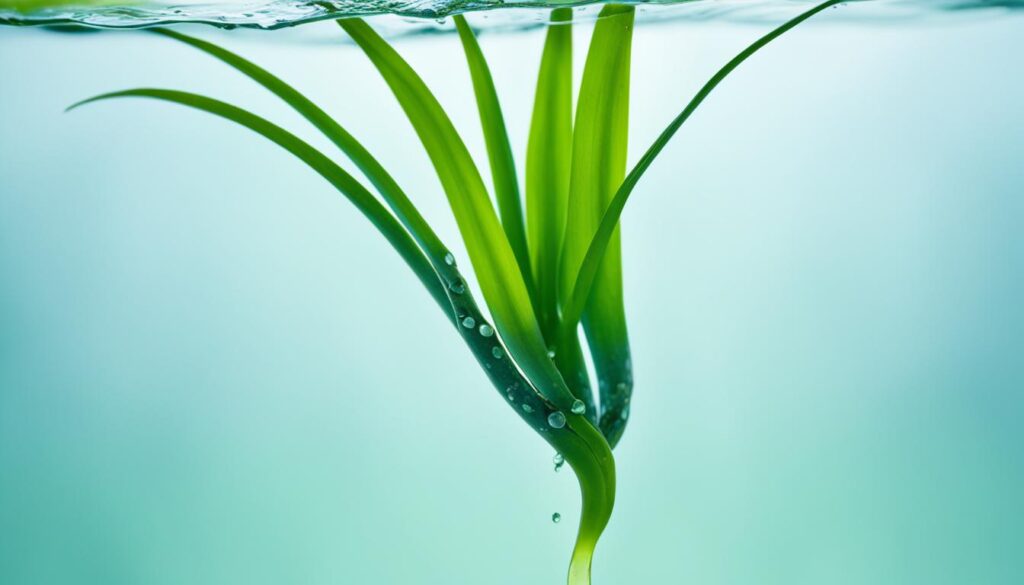
Growth and Development of Snake Plant / ‘Mother-in-Law’s Tongue’s
Snake Plants, or ‘Mother-in-Law’s Tongue’, grow slowly. They can get up to three feet tall indoors. It’s key to know how they grow. This helps you care for them right and keep them the right size at home.
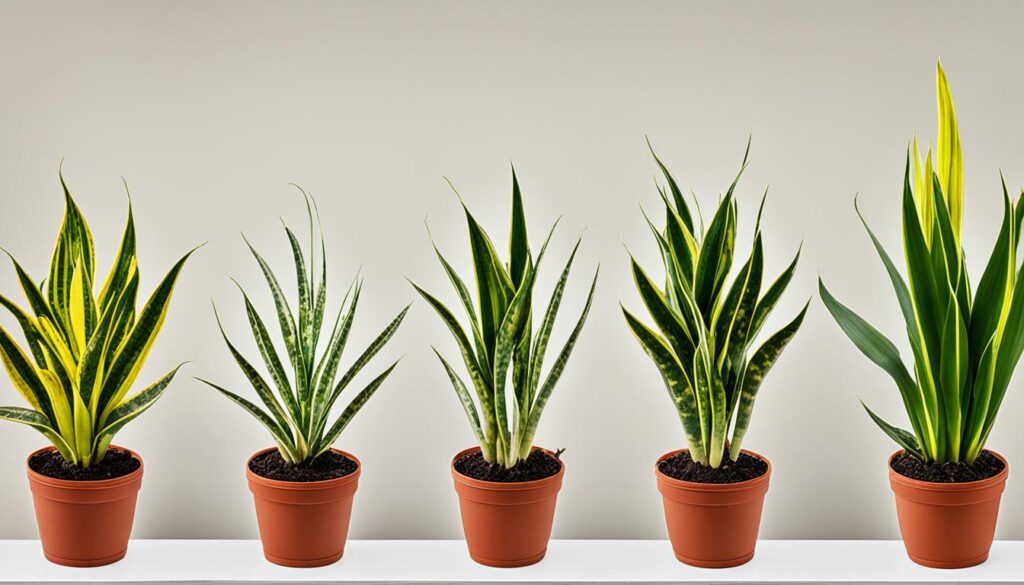
“The growth of a Snake Plant can change based on light, warmth, and care. They grow slowly but look very pretty. They make any room look nicer.”
Snake Plants grow up from the soil with stiff leaves. As they get older, their leaves get longer and stronger. This makes them great for adding a cool, upright look to any room.
The environment affects how fast a Snake Plant grows. Things like warmth, moisture in the air, and light matter a lot. The best conditions make the plant grow well and look healthier.
To keep your Snake Plant a good size, trim it now and then. Cut off any old or hurt leaves. This makes it look nice and grow new leaves. Also, putting it in a bigger pot when needed helps its roots grow. This helps the plant keep growing well.
Maintaining the Optimal Size
If you want your Snake Plant smaller, trim it regularly. Cutting the leaf tips makes it spread out, not just up. Cut off any yellow or droopy leaves to keep it looking neat and healthy.
Knowing how Snake Plants grow helps you take good care of them. Then you can enjoy these lovely plants in your space.
Dealing with Pests and Diseases in Snake Plant / ‘Mother-in-Law’s Tongue’s
I really like my Snake Plant, but it can get sick or have bugs. Just like us, it can have problems. We must know how to keep it healthy and happy.
“Prevention is better than cure.”
Many bugs like scales, gnats, and spider mites can attack your Snake Plant. They harm the leaves and make the plant weak.
But don’t worry! You can fight these bugs and keep your plant strong. Knowing what to do helps a lot.
Here are some easy tips to keep your Snake Plant safe from bugs:
- Look closely at your plant for any signs of bugs, like sticky leaves or tiny webs.
- Try safe ways to get rid of bugs, like using neem oil or soapy water.
- If bugs are everywhere, you might need to use special bug killer. Be careful following the directions.
- If one plant is sick, keep it away from your other plants to stop the bugs from spreading.
- Keep your plant area clean and airy to stop bugs from moving in.
Diseases can also trouble your Snake Plant, not just bugs. Too much water can cause root rot.
To stop diseases, remember these tips:
- Use pots that let water out and soil that doesn’t hold too much water.
- Don’t water your plant too much. Let the soil get dry before watering again.
- Take away any leaves that are dying to keep diseases away.
- Keep the air around your plant not too wet to stop fungus from growing.
- Don’t put too many plants close together. They need space for air to move.
| Pest | Characteristics | Treatment | Prevention |
|---|---|---|---|
| Scales | Small, armored insects that attach to leaves and stems; can cause yellowing and leaf drop. | Manual removal; use of insecticidal soap or neem oil. | Regularly inspect plants; isolate infested plants. |
| Gnats | Small flies that hover around the soil surface; can cause root damage and inhibit growth. | Allow soil to dry between waterings; use sticky traps or nematodes for control. | Avoid overwatering; ensure proper drainage. |
| Spider Mites | Microscopic pests that feed on plant sap; cause yellowing, webbing, and leaf damage. | Introduce natural predators like ladybugs or use miticides. | Maintain humidity; regularly mist foliage. |
| Aphids | Small insects that suck sap from plant tissues; cause curling leaves and sticky residue. | Use insecticidal soap or neem oil; introduce beneficial insects like lacewings or ladybugs. | Inspect new plants for aphids before introducing them to your collection. |
| Mealybugs | Small, cotton-like insects that feed on plant sap; cause yellowing and stunted growth. | Remove manually; use cotton swabs dipped in rubbing alcohol. | Regularly inspect plants; monitor for signs of infestation. |
| Whiteflies | Tiny insects that leave behind a white, powdery residue; cause yellowing and leaf drop. | Use yellow sticky traps; introduce natural predators like parasitic wasps. | Regularly clean foliage and inspect plants for signs of whiteflies. |
Common Snake Plant / ‘Mother-in-Law’s Tongue’ Pests
This part will talk about pests like scales, gnats, spider mites, and more. These pests harm Snake Plants.
Snake Plants can get sick from different pests. Knowing these pests helps you care for your plants.
“Knowing the specific characteristics of these pests will enable you to take proactive steps to protect your Snake Plants and prevent severe infestations.”
Here are some pests you might see on your Snake Plants:
- Scales: Tiny bugs that stick to leaves and stems. They look like bumps and eat plant sap. This makes plants weak and leaves yellow.
- Gnats: Little bugs like mosquitoes. They love wet soil and harm plants by laying eggs. Their babies eat roots, hurting the plant’s growth.
- Spider Mites: Tiny pests hard to see. They love dry places and make leaves yellow and webbed. This makes the plant sick.
- Aphids: Small, soft bugs on leaf bottoms. They eat plant sap. Leaves can turn yellow, twist, and curl if not stopped.
- Mealybugs: Small, white bugs in cottony groups on stems and leaves. They suck sap, making plants wilt and leaves yellow.
- Whiteflies: Tiny, white bugs under leaves. They make leaves yellow, wilt and fall off. They also make sticky honeydew that attracts other pests.
Learn the signs of pests on your Snake Plants. Check your plants often. Use safe bug sprays like organic soaps or oils to keep them healthy.
Natural Predators
Using natural predators helps control pests in Snake Plants.
These creatures keep your plants healthy and happy. Knowing how to use them can make your plants pest-free for a long time.
Isolate Infected Plants
If plants get sick with pests, keep them away from the healthy ones.
This stops the pests from moving around. It keeps all your Snake Plants safe.
Chemical Treatment
Sometimes, natural predators can’t handle all pests.
Then, chemicals might be needed. There are safe products for indoor plants like Snake Plants. Always use them safely and follow the instructions.
| Pest | Natural Predator |
|---|---|
| Scales | Ladybugs, Lacewings |
| Gnats | Hypoaspis mites, Predatory nematodes |
| Spider Mites | Predatory mites |
| Aphids | Ladybugs, Green lacewings |
| Mealybugs | Predatory beetles, Parasitic wasps |
| Whiteflies | Encarsia formosa, Aphidius colemani |
Disease Prevention For Snake Plant / ‘Mother-in-Law’s Tongue’s
Keeping Snake Plants healthy is key. Adequate light, humidity, and ventilation are important. Also, don’t water too much. A clean place helps avoid plant diseases.
| Disease | Symptoms | Prevention |
|---|---|---|
| Fungal Infections | Yellowing leaves, wilting, spots on leaves | Ensure good airflow, avoid overwatering, use well-draining soil |
| Bacterial Infections | Rotting stems, black spots, foul smell | Follow proper watering techniques, avoid leaf wetness, maintain cleanliness |
| Root Rot | Wilting leaves, mushy roots, plant detachment from soil | Allow soil to dry out between waterings, use well-draining pots and soil mix |
| Pests Infestation | Visible pests, yellowing leaves, distorted growth | Regularly inspect plants, isolate infected plants, introduce natural predators |
Snake Plants need adequate light for strong growth. They like bright, indirect sun. Too much direct sun can hurt their leaves.
They also enjoy moderate to high humidity. Increase humidity with a water tray or humidifier.
Don’t water too much to avoid root rot. Water only when the soil’s top inch is dry. Make sure pots drain well.
Keep their space clean. Remove dust, leaves, and debris. Check the plant for pests. Deal with any problems right away.
Tips for Maintaining Snake Plant / ‘Mother-in-Law’s Tongue’s
To keep your Snake Plants healthy and pretty, you should remember a few important tips. These tips will help your plants look great and grow well inside your home.
Wiping Leaves
It’s good to clean the leaves of your Snake Plants often. This keeps them free from dust and helps them make food from sunlight better. Just gently wipe each leaf with a soft, wet cloth or sponge. This will keep your plants looking bright and healthy.
Outdoor Exposure
Although Snake Plants usually live inside, they like some time outside too. If the weather is nice, let your plants enjoy some natural light and fresh air. But keep them out of direct sunlight to avoid leaf burn. Also, don’t let them get too cold or too hot.
Adjusting Watering Schedule
Snake Plants don’t need a lot of water, and too much can harm them. It’s key to water them less or more, depending on the time of year. Water more when it’s warm and growing time. Water less when it’s cold and they are not growing much. This keeps the roots healthy and stops them from rotting.
Following these tips will keep your Snake Plants looking lovely and healthy. Clean the leaves, give them some time outside, and water properly. Then, you can enjoy the beauty they add to your space.
Tips for Successful Overwintering of Snake Plant / ‘Mother-in-Law’s Tongue’
Keeping Snake Plants healthy in winter needs special care. Below are tips to help your plant stay alive:
- Temperature requirements: Snake Plants like warmth between 70-90°F in grow time. Yet, they can handle down to 50°F in winter. Be sure not to let them get colder than 45°F. Cold can hurt them.
- Watering adjustments: They drink less water in winter. Make sure the dirt dries more before you water again. Too much water can make roots rot.
- Protection from frost and cold drafts: They don’t like frost and drafts. Bring them inside or cover them when it gets freezing. Keep them away from drafty areas. Cold air can harm the leaves and plant.
Here’s a picture showing how to keep your Snake Plant safe inside in winter:
Follow these guidelines to help your Snake Plant make it through winter. This way, it will stay strong and beautiful for many years.
Growing Snake Plant / ‘Mother-in-Law’s Tongue’ from Seed
Growing Snake Plants from seeds is not as common. But it is possible. If you wish to grow Snake Plants from seed, this part will help you begin.
Varieties of Snake Plant / ‘Mother-in-Law’s Tongue’
Snake Plants are known as ‘Mother-in-Law’s Tongue’. They come in many types, each unique. They have different leaves, sizes, and ways they grow. Plant lovers enjoy these differences. Let’s look at some popular kinds:
1. Dracaena trifasciata ‘Hahnii’: This kind is small and has short leaves. It’s great for little spots and tables. The leaves are yellow at the edges. This makes any room look nice.
2. Dracaena angolensi: This Snake Plant stands tall. It has long, green leaves with light green lines. It’s eye-catching in any space.
3. Dracaena trifasciata ‘Laurentii’: The ‘Laurentii’ has yellow leaf edges. The center is dark green. It makes any area bright and interesting.
4. Dracaena trifasciata ‘Twisted Sister’: This one has twisty leaves. Their dark green leaves with light patterns are unique. It looks amazing in a plant collection.
5. Dracaena trifasciata ‘Bantel’s Sensation’: It has tall, skinny leaves with white lines. This makes it stand out. Plant lovers really like it.
6. Dracaena pearsonii: ‘Pearsonii’ is good for small rooms. It has dark green leaves with light patterns. It adds beauty and freshness to any room.
Every Snake Plant variety is special. You can pick one that fits what you like and need. If you want something small or something that stands out, there’s a variety for you.
FAQ
Q: Is the Snake Plant / ‘Mother-in-Law’s Tongue’ air-purifying?
A: Yes, it purifies air. It removes toxins and gives off oxygen.
Q: Is the Snake Plant / ‘Mother-in-Law’s Tongue’ pet friendly?
A: The plant is safe for cats and dogs. But, keep pets from chewing it to prevent bellyaches.
Q: How big does the Snake Plant / ‘Mother-in-Law’s Tongue’ get?
A: Snake Plants grow slowly but can get three feet tall indoors. Pruning and care keep their size manageable.
Q: How to choose the right pot and soil for Snake Plant / ‘Mother-in-Law’s Tongue’?
A: Choose a pot that drains well. It should be a bit bigger than the root ball.
Use soil that drains well too. A mix for succulents or one with potting soil, perlite, and sand works best.
Q: How much light does the Snake Plant / ‘Mother-in-Law’s Tongue’ require?
A: It likes indirect sunlight and a little direct morning sun. But too much sun can harm it.
This keeps it growing well and looking bright.
Q: How often should I water the Snake Plant / ‘Mother-in-Law’s Tongue’?
A: Snake Plants don’t need much water. Too much water can hurt them.
Let the soil dry before watering again. Usually, water every 2-6 weeks, depending on conditions.
Q: What is the recommended fertilizer for Snake Plant / ‘Mother-in-Law’s Tongue’?
A: Use a weak 10-10-10 fertilizer twice a year. Once in spring and again in summer.
This helps the plant grow strong and green.
Q: How to propagate Snake Plant / ‘Mother-in-Law’s Tongue’?
A: For stem cuttings, cut a healthy leaf into sections. Put them in water or moist soil.
To divide, separate offsets and plant them. Both ways make new plants.
Q: How do I maintain the overall health and appearance of Snake Plant / ‘Mother-in-Law’s Tongue’?
A: Wipe the leaves to keep them clean. Adjust water with the seasons. Sometimes, let them be outside.
Keep the area clean and trim away bad leaves for best health and looks.
Q: What are some common pests that can infest Snake Plant / ‘Mother-in-Law’s Tongue’?
A: Pests like scales, gnats, spider mites, aphids, mealybugs, and whiteflies can bother it. Check for signs like discoloration or sticky leaves.
Q: How can I control pest infestations in my Snake Plant / ‘Mother-in-Law’s Tongue’?
A: Use ladybugs or other good bugs. Isolate sick plants and treat them with safe bug spray or neem oil if needed.
Q: How can I prevent diseases in Snake Plant / ‘Mother-in-Law’s Tongue’?
A: Give them enough light, the right moisture, and good air. Don’t overwater.
A clean place and good care keep diseases away.
Q: How do I overwinter Snake Plant / ‘Mother-in-Law’s Tongue’?
A: Keep them warm, above 50°F. Water less and protect them from cold air and frost.
Good light and a stable place help them in the cold.
Q: Can I grow Snake Plant / ‘Mother-in-Law’s Tongue’ from seeds?
A: Yes, you can grow them from seeds. Use good seeds.
Provide the right care for the young plants.
Q: What are some popular varieties of Snake Plant / ‘Mother-in-Law’s Tongue’?
A: Popular types include Dracaena trifasciata ‘Hahnii’, Dracaena angolensi, and others. Each type looks different.

